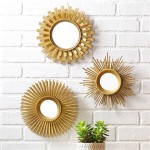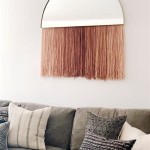How to Hang a Mirror on a Wall
Mirrors are a versatile home decor element, capable of enhancing the space, brightening rooms, and reflecting light. Whether a full-length mirror for a bedroom, a decorative accent mirror for the living room, or a small bathroom mirror, hanging it securely and aesthetically is crucial. This guide provides a comprehensive overview of how to hang a mirror on a wall, ensuring a successful and safe installation.
1. Choosing the Right Tools and Materials
Before embarking on the hanging process, gathering the necessary tools and materials is essential. The tools required vary depending on the mirror's weight and the wall material. However, a standard set typically includes:
- Level: A level ensures the mirror is hung straight, achieving a visually appealing and balanced look.
- Measuring tape: This tool is vital for accurately measuring the mirror's dimensions and determining the ideal placement on the wall.
- Pencil: A pencil is used to mark the precise location of the mirror on the wall before drilling.
- Hammer: A hammer is essential for driving nails or picture hooks into the wall.
- Screwdriver: This tool is needed if using screws instead of nails or picture hooks.
- Drill with appropriate bits: A drill is necessary to drill pilot holes for screws, particularly for heavier mirrors or walls that require it.
- Safety glasses: Protect your eyes from debris or dust during the hanging process.
- D-rings or picture hangers: These are used to attach the mirror to the wall, providing secure support based on its weight.
- Wire or string: Connecting D-rings to picture hangers requires a strong wire or string.
- Wall anchors (if needed): In certain situations, wall anchors may be required to reinforce weak drywall or plaster walls.
2. Determining the Ideal Location and Measuring
The location of the mirror is crucial for its intended purpose and aesthetic appeal. Consider the following factors:
- Functionality: If the mirror is functional, like a dressing mirror, place it where it is easily accessible and provides adequate lighting.
- Visual impact: If the mirror is purely decorative, choose a location that enhances the room's design and highlights specific features.
- Safety: Ensure the mirror is not placed in a high-traffic area or where it could be easily knocked over.
Once the location is determined, measuring is essential. These steps ensure proper placement and prevent the mirror from being hung crooked:
- Measure the mirror's width and height: Use a measuring tape to accurately measure the mirror's dimensions, ensuring it fits the chosen location.
- Mark the center point of the mirror: Divide the mirror's width and height in half to find the center point. This point will be the reference point for aligning the mirror on the wall.
- Mark the center point on the wall: Using a pencil, transfer the mirror's center point to the chosen wall location. This mark will guide the placement of the hanger or D-rings.
3. Attaching the Hangers or D-rings
The next step is to attach the hangers or D-rings to the mirror, ensuring they are positioned correctly for secure hanging. Here are the general steps:
- Determine the appropriate hanging method: The weight of the mirror dictates the hanging method. For lightweight mirrors, picture hooks may suffice, while heavier ones require D-rings and wire for added support.
- Position the hangers or D-rings: If using D-rings, position them on the back of the mirror, ensuring they are level and equidistant from each other. If using picture hooks, determine their placement based on the mirror's weight and the wall material.
- Attach the hangers or D-rings securely: Use appropriate screws, nails, or adhesive to firmly attach the hangers or D-rings to the mirror. Ensure they are securely fastened to prevent the mirror from falling.
4. Installing the Hangers on the Wall
With the hangers or D-rings attached to the mirror, the next step is to install them on the wall. This process involves:
- Check for studs: If using screws, locate studs in the wall for optimal support. A stud finder can aid in this process, allowing for a secure and stable installation.
- Mark the hanger locations on the wall: Using a pencil and level, mark the precise locations for the hangers on the wall, ensuring they are aligned with the mirror's center point.
- Drill pilot holes (if necessary): For denser materials or heavier mirrors, drilling pilot holes before driving screws is recommended. This prevents splitting the wall and ensures a secure installation.
- Install the hangers: Drive screws, nails, or hammer picture hooks into the wall at the marked locations, ensuring they are properly installed and secure.
5. Hanging the Mirror
Finally, with the hangers securely installed on the wall, it's time to hang the mirror. This process involves:
- Align the mirror with the hangers: Carefully lift and position the mirror against the wall, ensuring it is aligned with the hangers. This step requires caution and assistance from another person, especially for heavier mirrors.
- Securely attach the mirror to the hangers: Once the mirror is in place, securely attach it to the hangers. If using D-rings, thread a wire or string through them and hang the mirror from the wall hooks. If using picture hooks, ensure the hooks are securely engaged with the mirror's hanging holes.
- Double-check the mirror's level: After the mirror is hanging, use a level to ensure it is perfectly straight. If not, readjust the position slightly until it is level.

How To Hang A Large Or Heavy Mirror

How To Hang A Heavy Mirror The Home Depot

How To Hang A Frameless Mirror On The Wall With Pictures

How To Hang A Heavy Mirror Lowe S
How To Hang A Heavy Mirror On Drywall Without Damaging It Or The Wall Quora

How To Hang A Heavy Full Length Leaner Mirror On The Wall House Of Hepworths

How To Hang A Heavy Full Length Leaner Mirror On The Wall Hanging Mirrors

3 Simple Ways To Hang A Mirror On Wall Without Nails Wikihow
:strip_icc()/ScreenShot2022-04-28at1.12.19PM-e055476c70c6438585fa7c5cd531edcf.png?strip=all)
4 Easy Ways To Hang A Heavy Mirror

How To Hang A Heavy Mirror Lowe S








